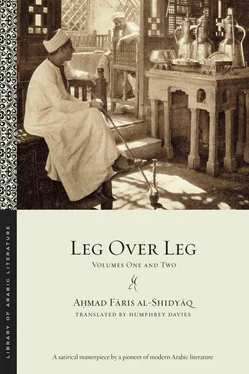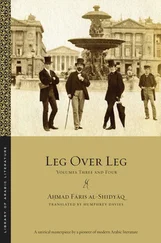During this period, al-Shidyāq launched the Jawāʾib Press; in 1870 he began printing his periodical himself (with the assistance of his son, Salīm), as well as his book-length works, the works of his supporters and friends, and classical works on Arabic language and literature. Many of these were devoted to philological inquiry, including works on the morphology, lexicography, and phonology of Arabic, most notably Al-Jāsūs ʿalā l-Qāmūs ( Spying on the Dictionary , 1884) and Sirr al-Layāl fī l-qalb wa-l-ibdāl ( The Secrets of Morphology and Metathesis , 1884) as well as a comparative study of Arabic, French, and Turkish ( Kanz al-lughāt; The Treasury of Languages , 1876). As Geoffrey Roper notes, al-Shidyāq “did not just passively accept and make use of the printing press” but was “an active protagonist and propagandist of the print revolution.” 26Al-Shidyāq helped to establish many of the norms of modern printing — from language to typesetting — including the addition of tables of contents and title pages with dates. As he argued, “all the crafts that have been invented in this world are inferior to the craft of printing.” 27
Al-Shidyāq operated the Jawāʾib Press from 1870 until three years before his death, when he was perhaps able to devote his full attention to his final project — a critical edition and introduction to the seventh/thirteenth-century dictionary, Lisān al-ʿArab ( The Arab Tongue , 1883–89) of Ibn Manẓūr. Published in twenty volumes at the Bulāq Press in Cairo, it remains one of the largest dictionaries in Arabic and a near-exhaustive source for rare words — one of al-Shidyāq’s particular passions, as evidenced in Leg over Leg ’s extensive lists of synonyms and near-synonyms. His final journey, in a life of traveling, was to Cairo in 1886, in order to confer with the press about its publication. A fellow author and literary biographer described his visit:
Old age had overtaken him, dimmed his eyes, and bent his back; but he had lost nothing of his keenness or intelligence. He was, until the last of his days, a pleasant conversationalist with graceful expressions, amiable — with a tendency towards profanity. 28
Eloquent and profane until the last, al-Shidyāq died, shortly after his return from Egypt, in the village of Kadiköy, on September 20, 1887. Some biographers claim that he converted back to Maronite Catholicism on his deathbed, but his own final wishes seem to contradict this. Never one to settle such questions simply, he requested to be buried in a Christian cemetery near his family home in Hazmiyyah, Lebanon, in a grave marked not by a cross but by a crescent. 29
Al-Shidyāq, then, was paradoxical even in death, as is fitting, considering the broadest strokes of his biography. In the (perhaps understated) words of the missionary society’s annual report, “Fāris is a man of excellent mind, but strong and wayward passions”—an apt way to describe many of his political and religious affiliations. He wrote poems in praise of Aḥmad Bāy of Tunis but also of Queen Victoria and the rebel leader ʿAbd al-Qādir of Algeria, and he became a British citizen before leaving England to work as a subject of the Ottoman Empire. To quote Kamran Rastegar, he was a “Muslim Christian. A sedentary traveler. An ascetic sensualist. A modernist classicist. A literary gutter-mouth. A pious unbeliever.” 30He was, intellectually and personally, a series of irresolvable paradoxes.

Al-Shidyāq’s body of work — seen as a whole — is equally difficult to categorize neatly. Most frequently, al-Shidyāq is seen as a modernizer, a renovator of Arabic letters who “had little regard for literary tradition” and who instead looked to Europe for literary modes that would replace those discredited indigenous ones. 31In a certain sense this is true: he was a pioneer of narrative forms new to the Arab public sphere, including the modern travelogue and experimental narrative prose such as we find in Leg over Leg . Known as the father of Arabic journalism for his work on Al-Waqāʾiʿ al-Miṣriyyah and Al-Jawāʾib , he was invested in the modernization of the Arabic language, so as to preserve its usefulness and expressiveness in modern daily life. Thus, he introduced many surviving neologisms that described his contemporary reality, including jarīdah “newspaper,” intikhāb “election,” and jawāz “passport,” and he translated and edited English translations of religious, geographical, pedagogical, natural historical, and narrative works. His literary career, that is, showed a sustained engagement with European languages, scholarship, and literary forms.
And yet much of his published work consists of works one might classify as neo-classical, or even “revivalist,” including influential studies in classical lexicography and critical editions of classical Arabic texts, as well as original compositions in neo-classical style, such as his poetry and his examples of maqāmāt (a rhyming prose form that originated in the fourth/tenth century but that was produced by many during the Nahḍah ). 32These works, comprising much of his prolific production, signal that al-Shidyāq was not interested simply in abandoning inherited Arabic literary modes and rhetorical styles: he was equally interested in reviving classical rhetoric and forms and publishing them for the new reading public. 33His modernity, that is, was pioneered precisely through an interest in Arabic literary pre-modernity.
In this sense, al-Shidyāq’s oeuvre exemplifies the diverse trajectories of the Nahḍah . Yet, despite the diversity of its output, the Nahḍah had for many years been seen as an enlightenment movement with its primary origins in “Western influences, the introduction of unknown or barely known genres such as the theatre or the European-style novel” or which “loosened the attachment of Arab societies to traditions reckoned inappropriate to modern civilization.” 34In recent years, however, scholars have looked at the production of the Nahḍah as more ambivalent in its attitude toward Western literary and cultural models and less categorical in its rejection of indigenous ones. Studies of translation and literary contact in the Nahḍah now tend to see experimentations in Western forms not as admiring imitations of a dominant culture but as creative acts of cultural resistance or indifference that “cared nothing for origins and genealogies.” 35And intra-regional studies have questioned the extent to which these works should be viewed solely in conversation with the West. These studies point to more continuities than discontinuities with the literary heritage of the East, and show us that looking at the literature of the Nahḍah solely in the context of its relationship with the West writes out a significant part of the period’s output: not only “revivalist” literature (classical and neo-classical publications) but also those works that lie between revivalist and “modernist,” such as Leg over Leg . 36
The Nahḍah , in light of these recent studies, might more precisely be understood as a period of dynamic social and literary change, which oriented its modernity simultaneously inward, toward a classical heritage, and outward, in the direction of Europe. Indeed, Samah Selim has gone as far as to suggest abandoning the singular term Nahḍah , in order to “speak of two intertwined literary Nahḍah s”: “one that, partly looking backwards to an antediluvian ‘golden age,’ was invested in an act of genetic and linguistic recuperation (re-naissance) and another that was strictly materialist in the play of its textual and social articulations.” 37That is, one Nahḍah that recovers a literary past and another that represents , in varying degrees of realism, a material present, which included goods and people from both inside and outside the Arabic-speaking world, or the “Arabs and their non-Arab peers” of Leg over Leg ’s subtitle, or those disconnected and newly connected by steamships and railways, to paraphrase the Fāriyāq.
Читать дальше













